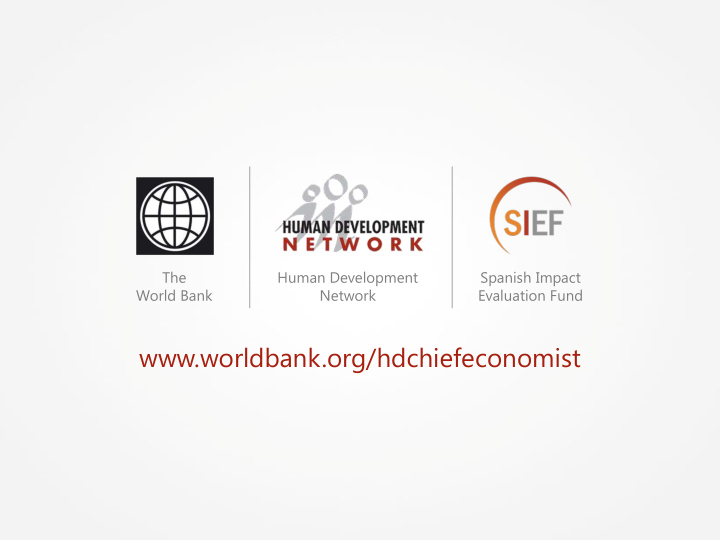



The Human Development Spanish Impact World Bank Network Evaluation Fund www.worldbank.org/hdchiefeconomist
Evaluating Impact: Turning Promises into Evidence Improving Maternal and Child Health using RBF Charles, Caroline, Rejoice, Patience and Dinah Accra, Ghana May 2010
1. Background Ghana has made great strides towards achieving MDGs in the past 5 years, the under five mortality reduction was 28% and the infant mortality reduction was 22% (GDHS2008). But special effort is needed for MDGs 4&5: • Under 5 mortality Ghana needs to have a reduced by 35% • Infant mortality by 48% • Maternal mortality ratio for 2007 was 451/100.000 live births. Study site -The Northern & Eastern region • Needs a reduction of 36% of under five mortality and 51% of infant mortality.
Background cont’ • The children who completed all standards vaccines are only 76% (national coverage of 79%) • Malnutrition-stunted children =38% (national malnutrition level of 28%) • The unmet needs for family planning is 40% (national level =35%). • Eastern region, has a bit higher institutional birth/delivery (59%) (national level =57%), but very low maternal mortality reduction.
… o The outcomes related to family planning, maternal health, child health, nutrition, malaria shows important variable gaps in demand and supply services:
2. Results Chain LONGER-TERM INPUTS ACTIVITIES OUTPUTS OUTCOMES OUTCOMES HIGHER ORDER GOALS Improved Quality Healthy Number of Personnel Providers( o o o o Providers Care: mothers with required Doctors , and Schemes Healthy competencie nurses and o o Increased 4+ children trained s midwives) ANC visit Reduced Healthy Implementati Essential hired/trained o o o o pregnancy Community on manuals medicines, o Health and developed related Increased life vaccines & o Scheme complication A wareness of expectancies logistics o providers s of women improved Basic o trained (living M&C health Equipment Developmen o Increased o longer) services and supplies t of IPT3 created Children Means of Standards o coverage o Number of living longer transport and Training o o Increased pregnant including Manual for proportion of women seen ambulance, personnel births at ANC and other (Providers, attended by vehicle Schemes) o skilled health Number of personnel births o Providers Improved o attended by practicing Referrals skilled health according to o Reduced personnel standards maternal and mortality guidelines
2. Results Chain – cont’d LONGER-TERM INPUTS ACTIVITIES OUTPUTS OUTCOMES OUTCOMES HIGHER ORDER GOALS Standard & o Happy and o o o Reduced Reduced o Awareness Evidence infant (under satisfied maternal Creation for based 1) death rate women and morbidity women and guidelines o o Reduced children Number of community Training o under-5 pregnant o Registration manual for death rate women seen of pregnant providers o Increased at PNC; women Plans, o o contraceptiv Number of o Registration budgets, e utilization pregnant of Children finance & rate women using at ANC Accounting Registration o Reduced o FP services MIS o of children at adolescent Number of o equipment PNC pregnancy children Clients/ o Registration ‘birth rate Immunized o Beneficiaries of women at o Increased Number of o (children maternity proportion of children under 5 and wards 1-year-old dying before WIFA) children age 1 Catchment o immunised Number of o area Improved o children Incentives for o BEONC & dying before S and D CONC, age 5 Number of o
2. Results Chain – cont’d LONGER-TERM INPUTS ACTIVITIES OUTPUTS OUTCOMES OUTCOMES HIGHER ORDER GOALS Increased FP , Level of .. o o o Determining incentives SD, FANC, the level of FPNC determined for incentives for uptake both S&D S and D Increased Routine Data o o utilization of Collection Maternal Routine o health Supervision services Quarterly o Increased M&E o utilization of child welfare services Waiting time o shortened Client o satisfied with services
3. Primary Research Questions Will monetary incentives lead to increased 4+ANC and 3+PNC visits Will monetary incentives lead to increased utilization of ITN among pregnant women and under 5s Will monetary incentives motivate health personnel to improve quality of care Reduced birth outcomes - Early identifications of complication and referrals Reduced attitudinal changes Reduced institutional maternal morbidity Will supervised delivery reduce maternal and child morbidity and mortality Will increased PNC visits lead to reduced child morbidity? Will increased PNC visit lead to identification and treatment of danger signs in mother and child.
4. Outcome Indicators Percentage increase in utilization of 4+ ANC services lead to improved birth outcomes – mother and baby Percentage increase in utilization of 3 PNC services lead to improved maternal and infant health Percentage increase in ITN utilization will lead to reduction in malaria and anemia in children Percentage decrease in the incidence of birth complications Percentage decrease in waiting time of referred cases – mothers and under 5s Percentage increase in skilled birth attendance Percentage reduction in institutional maternal deaths Percentage reduction in low births babies with Percentage reduction in institutional neonatal /infant/under5 deaths
5. Identification Strategy/ Method Purchaser- DHIS Beneficiaries – Health Centres and Pregnant Women Monitoring- Existing Systems at DHMTs and Outsourcing Incentives paid quarterly to Health Centres Project Evaluation – Consultants Method Cluster randomized study Regression analysis Diff in diff Identification of study sites Infant mortality Under 5 mortality Supervised delivery rates Malnutrition rates EPI coverage
6. Sample and Data 200 HCs In 34 dist in 2 ER,NR S LSI U HSI 100 P 100 HCS HCs P L Y Input S Input based Incentive Incentive I based 50 based 50 based 50 D 50 HCs HCs HCs HCs E DEMAND SIDE Control Treatment Treatment Control BASED ON WIFA & FUND
7. Time Frame / Work Plan Activity Date Responsible Persons Complete Draft Detailed Proposal May 2010 Project Team Validation Workshop with June 2010 Project Team stakeholders Submission of Final Proposal July 2010 Project Team Funding Approved & Released Sept 2010 World Bank and Govt of Ghana Implementation of Project 2011-2013 DHIS, GHS Evaluation (Baseline and follow-ups) 2011, 2012, 2013 Consultant
8. Sources of Financing Government of Ghana World Bank
Recommend
More recommend